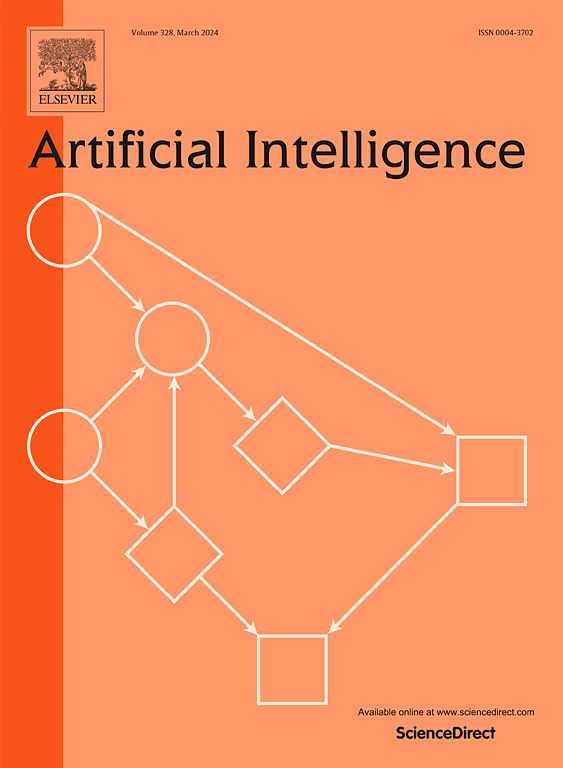The incentive guarantees behind Nash welfare in divisible resources allocation
IF 4.6
2区 计算机科学
Q1 COMPUTER SCIENCE, ARTIFICIAL INTELLIGENCE
引用次数: 0
Abstract
We study the problem of allocating divisible resources among n agents, hopefully in a fair and efficient manner. With the presence of strategic agents, additional incentive guarantees are also necessary, and the problem of designing fair and efficient mechanisms becomes much less tractable. While there are flourishing positive results against strategic agents for homogeneous divisible items, very few of them are known to hold in cake cutting.
We show that the Maximum Nash Welfare (MNW) mechanism, which provides desirable fairness and efficiency guarantees and achieves an incentive ratio of 2 for homogeneous divisible items, also has an incentive ratio of 2 in cake cutting. Remarkably, this result holds even without the free disposal assumption, which is hard to get rid of in the design of truthful cake cutting mechanisms.
Moreover, we show that, for cake cutting, the Partial Allocation (PA) mechanism proposed by Cole et al. [1], which is truthful and -MNW for homogeneous divisible items, has an incentive ratio between and when randomization is allowed, can be turned to be truthful in expectation. Given two alternatives for a trade-off between incentive ratio and Nash welfare provided by the MNW and PA mechanisms, we establish an interpolation between them for both cake cutting and homogeneous divisible items.
Finally, we study the optimal incentive ratio achievable by envy-free cake cutting mechanisms. We first give an envy-free mechanism for two agents with an incentive ratio of 4/3. Then, we show that any envy-free cake cutting mechanism with the connected pieces constraint has an incentive ratio of .
可分割资源分配中纳什福利背后的激励保障
我们研究在n个代理之间分配可分割资源的问题,希望以公平和有效的方式进行。由于战略代理人的存在,额外的激励保证也是必要的,设计公平有效机制的问题就变得不那么容易处理了。虽然针对同质可分物品的战略代理人的积极结果非常多,但据了解,其中很少有人会切蛋糕。我们发现,最大纳什福利(MNW)机制提供了理想的公平和效率保证,对同质可分物品的激励比为2,对切蛋糕的激励比也为2。值得注意的是,即使没有自由处置假设,这一结果也成立,而自由处置假设在真实切饼机构的设计中是难以摆脱的。此外,我们表明,对于切蛋糕,Cole等人提出的部分分配(PA)机制,对于同质可分物品是真实的和1/e- mnw,其激励比在[e1/e,e]之间,当允许随机化时,可以在期望上变为真实。给定由MNW和PA机制提供的激励比和纳什福利之间的权衡的两种选择,我们在切蛋糕和同质可分项目之间建立了插值。最后,研究了无嫉妒切蛋糕机制所能达到的最优激励比。我们首先给出了两个主体激励比为4/3的无嫉妒机制。然后,我们证明了任何具有连通片约束的无嫉妒切饼机制的激励比为Θ(n)。
本文章由计算机程序翻译,如有差异,请以英文原文为准。
求助全文
约1分钟内获得全文
求助全文
来源期刊

Artificial Intelligence
工程技术-计算机:人工智能
CiteScore
11.20
自引率
1.40%
发文量
118
审稿时长
8 months
期刊介绍:
The Journal of Artificial Intelligence (AIJ) welcomes papers covering a broad spectrum of AI topics, including cognition, automated reasoning, computer vision, machine learning, and more. Papers should demonstrate advancements in AI and propose innovative approaches to AI problems. Additionally, the journal accepts papers describing AI applications, focusing on how new methods enhance performance rather than reiterating conventional approaches. In addition to regular papers, AIJ also accepts Research Notes, Research Field Reviews, Position Papers, Book Reviews, and summary papers on AI challenges and competitions.
 求助内容:
求助内容: 应助结果提醒方式:
应助结果提醒方式:


